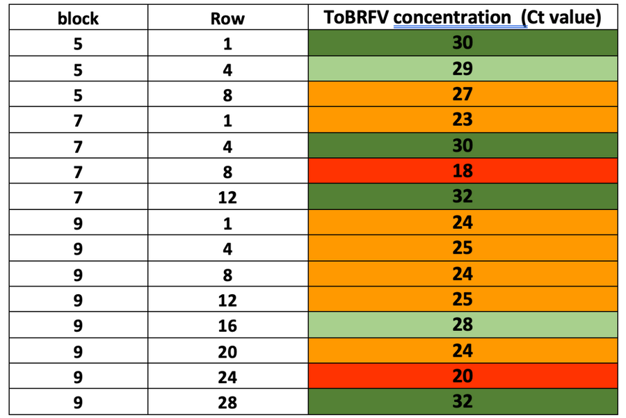The spread of Tomato Brown Rugose Fruit Virus (ToBRFV) through a greenhouse can be slowed down so overall damage can be less severe. The financial impact of the disease has to be taken into account as producers will need to find the right balance between the cost of prevention and yield loss.
It is unknown where, when, and at how many locations in the greenhouse the virus starts. Early detection is important as described before. Hygiene is also key when it is not known if the virus is already inside the greenhouse.
Basic spreading theory
Assuming that the infection starts with 1 plant. After around 10-14 days there is so much virus in the first plant that transmission takes place to the neighboring plants, it is assumed that 5-10 plants will be infected. This second group of 10 infected plants will be spreading the virus also after 10 days, to the next 50-100 plants. Taking into consideration the speed of the virus spread; approximately up to 3 -4 rows of plants will be infected in 2-4 weeks.
This is also described in this article: Spread of Tomato Brown Rugose Fruit Virus in Sicily and Evaluation of the Spatiotemporal Dispersion in Experimental Conditions. Stefano Panno, et al, 12 June 2020 (https://doi.org/10.3390/agronomy10060834).
In this research, 2 plants were infected indicated by the first 2 red dots in the first month. One month later the virus was detected in an additional 3 and 4 plants. At 3 months the virus is spread mainly downstream with labor activities reaching about 10 plants and also a little upstream and even into the adjacent rows. In month 4 the spread of the virus has been enormous. This can be due to continued crop work, weather changes or other factors. Bumble bees are also mentioned as the reason for the diagonal spreading of the virus.
It is important to realize that when plant 1 and certainly when 10 plants are infected, the virus will most likely move further away than the neighboring plants and rows. As can be seen in the figure, at the 4th month where there is a single red dot at the end of one of the middle rows with many 'clean' plants around. This shows that people, the trolleys, and possibly bumble bees can spread the virus to clean plants further away, up to 5 to 10 rows, to the opposite site of the path and maybe even much further. After roughly 4 weeks the virus may be present in multiple spots around the initial spot which then leads to spread to more plants in a similar way.
Spreading in a greenhouse
This is also seen in the grower greenhouses. Infected areas, represented by red spots, could be followed by noninfected areas, indicated by green spots, see table. The experience is that red spots do increase with a speed of 1-2 rows a week.
Between those red spots, green spots are present which stay sometimes surprisingly a long time 'green', that is, not so much infected. Of course, infection continues and green spots generally are "absorbed" by the red spots over time.
Experience tells us that the spread of the virus from the initial spot is limited. Studies have shown that the virus is picked up by trolleys and personnel and is moved mainly to the next rows. Despite high virus titers often measured in plants and on trolleys, the virus is not moved to all following rows, or at least not moved in a way that results in infection developing.
The table below shows example of the differences of ToBRFV concentration between rows in the same block in a greenhouse. ToBRFV was measured with qPCR and expressed in Ct values. Rows not presented were not tested.

"Our experience tell us that the spread of the virus from the initial spot is limited. The studies have shown that the virus is picked up by trolleys and personnel and is moved mainly to the next rows." Harmen Hummelen and Leonie Hogendonk: Vegetables by Bayer Field Quality Lead and Market Development North Europe Protected.
Reducing spreading
If the transmission from the initial plant to the whole row or to multiple rows takes several weeks, as is shown in the figure above, an initial infection can be restricted to a certain area.
Early detection and restricting the area will reduce the spread. New 'red' spots of infection developing are related to people or trolleys moving to 'green' uninfected spots. People and trolleys should have designated working areas (rows, compartments, blocks, etc.) and remain in their 'own' areas.
Separating grower's location or a greenhouse into multiple blocks looks really useful for reducing virus spread. This separation can be by greenhouse or by blocks in a greenhouse. Complete separation of the canteen and packing and transport ways is often not possible. The standard theory is that reducing the movement of people and trolleys from going all over the place will also reduce the number of new emerging 'red' spots. This theory is confirmed by growers who take certain measures to quarantine rows or blocks.
Limiting access to infected areas reduces the spread of the virus. In theory, this can result in that next infections will start 4-12 weeks later. Every week an infection is postponed, it will keep those 'green' plants producing longer at a normal level.
Restricting areas can lead to extra costs and those have to be taken into account. On the other hand, a faster infection of the greenhouse will reduce the yield. How fast an infection will go and how big the yield loss will be is difficult to calculate. Every grower has to decide which strategy is most favorable in their situation.
Hygiene and dividing the greenhouse into separate blocks will reduce the spread of the virus considerably. Even with resistant varieties, this will be the new way of plant health management.
For more information:
Bayer
www.bayer.com
